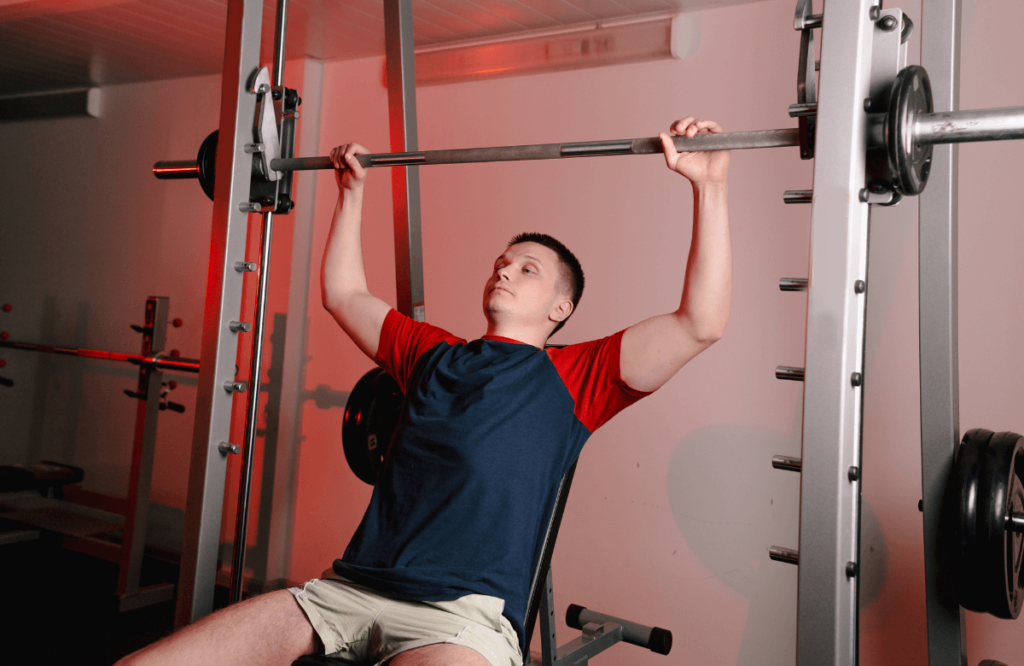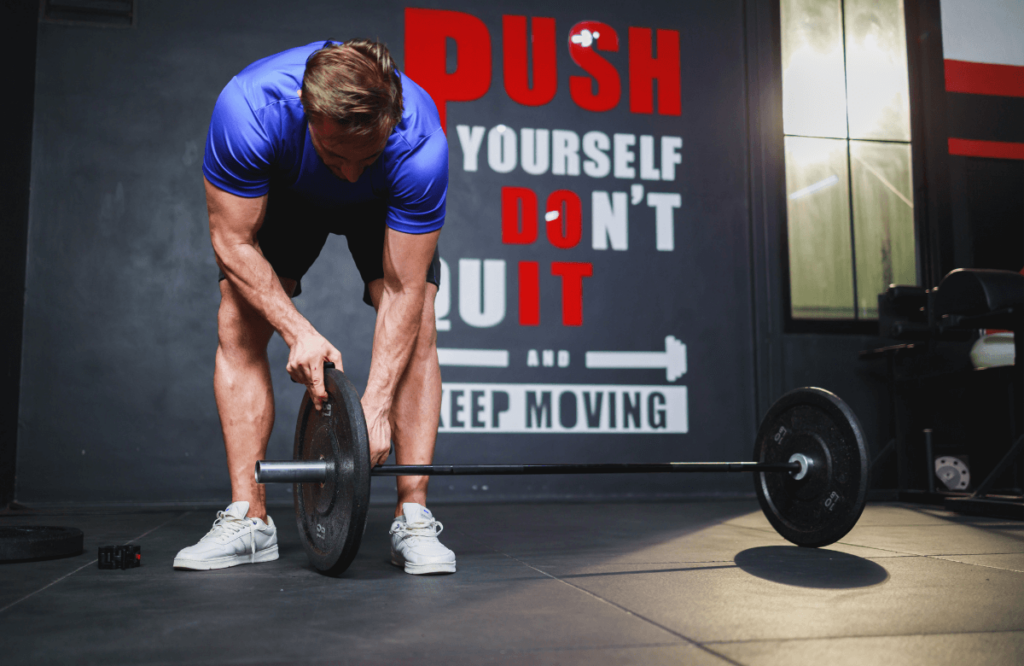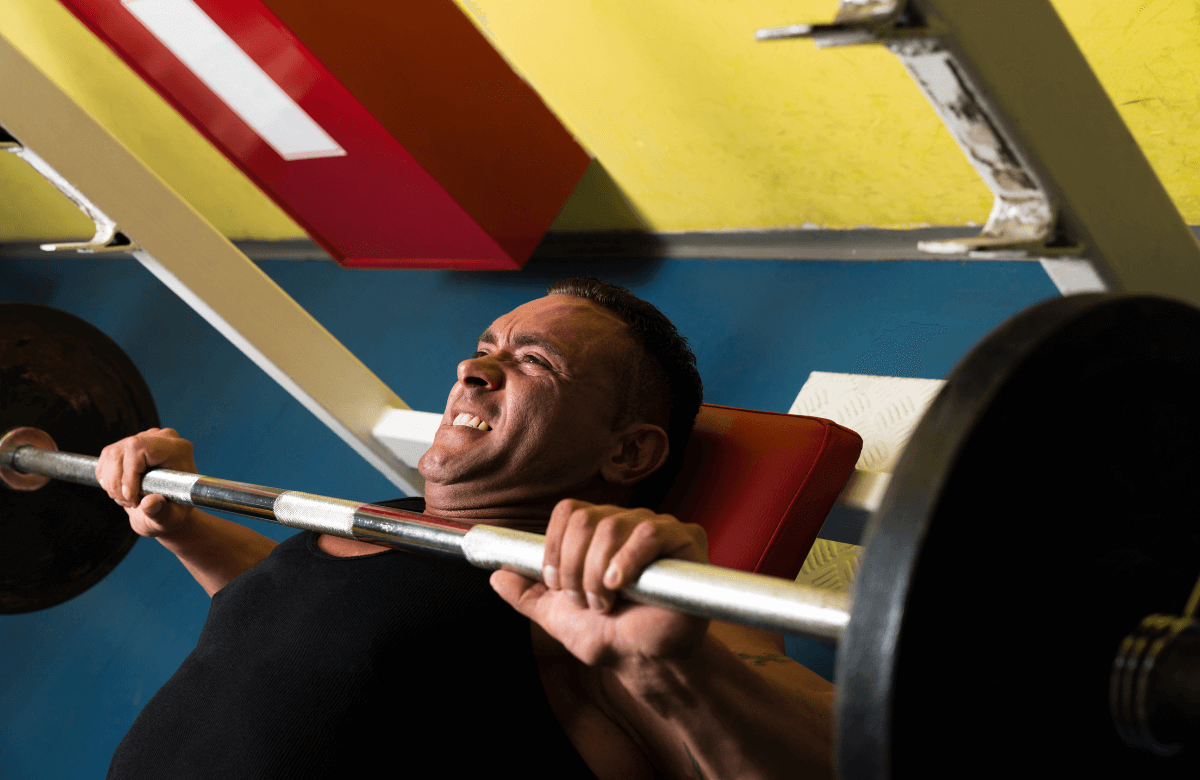Can you believe a tool as simple as a barbell can increase the size and definition of your chest in just a few short weeks? With this one simple piece of equipment, we’ll show you many different ways you can work every part of your upper chest, triceps, and lats.
With consistent training and the steps we’re going to outline below, you could notice a difference in your chest muscles in no time. Let’s take a closer look and get those pectoralis major muscles worthy of notice!
Jump to:
What Muscles Do You Work with Barbell Chest Workouts?
Your shoulders, arms, and pectoral muscles all get a good workout using the barbell combined with a weight bench. Specifically, you’ll be targeting your pectoralis major and pectoralis minor, which are the front part of your chest and parts of your upper arms.
The pectoralis major and pectoralis minor are often referred to as the “push” muscles because they’re the muscles you use when exerting any force with your arms. To strengthen them, you’ll need to perform pushing and resistance movements, and barbells are great for this job.
Secondary muscles you’ll work with barbell chest exercises include the head of your triceps muscles, core stability, and even the head of your biceps. You won’t see muscular hypertrophy in these areas, but you’ll definitely add some strength.
In this article, we’ll take a closer look at the variety of chest exercises that work your upper body from every angle. These targeted chest exercises build those upper body muscles quickly and effectively.

What Are the Benefits of Barbell Chest Workouts?
There are so many reasons to incorporate the barbell into your chest day workouts. For starters, this one piece of equipment is extremely versatile, and you can use it to tone and define your upper chest muscles, shoulders, and more.
A few other benefits include endurance, improved posture, better breathing, and stronger arms, pectoral muscles, and shoulders.
Increased Upper-Body Strength
You’ll be hefting heavier loads in no time as you increase your upper body strength through regular barbell chest exercises. Your shoulder joints will thank you as your stabilizer muscles increase in strength and become more supportive.
More Toned Pecs
The definition in your pectoral muscles will be hard to miss, especially during swimsuit season. A well-developed chest comes from using your push muscles with heavier and heavier resistance. As your muscles tear and repair themselves over and over again, you’ll soon have that muscular chest you’ve always dreamed of.
Even Muscle Growth
Compared with chest exercises using a resistance band, dumbbells, or cable machine, barbell chest workouts yield more even muscle growth. The weight distributed evenly across the barbell helps to build both sides of your arms and chest equally. It’s also easier to spot an imbalance as one side may feel heavier than the other.
The key to maintaining even muscle growth in your pecs and arms is to keep your core tight and use your chest to push and pull. This will enable your body to isolate the correct muscles and you’ll see greater growth accordingly.
Corrects Muscular Imbalances
Proper form can correct muscular imbalances and be easier to spot when using a barbell for bench press. Focus on your technique making sure both sides are lifting equally.
As you lift or push the barbell, notice how your chest and shoulder muscles respond. If one side is heavier than the other, you can adjust your grip or position to help prevent compensation injuries. More even strength gains mean less injury risk in your future.

A Note on Safety When Doing Barbell Exercises
When beginning any new workout routine, always consult your physician. An assessment from a certified personal trainer can go a long way to achieve the results you want and avoid injury. Knowing the proper form and technique is an absolute must when it comes to weight training.
Additionally, make sure you have a spotter present when performing workouts with the bar overhead. Barbell chest exercises often involve pushing the bar above your head and chest as you lie on a workout bench, and if you drop the bar without a spotter to help, you could risk serious injury.
Many gyms will provide a spotter if you ask, so take advantage of the service for your safety.
Best Beginner Barbell Chest Workouts
One of the best ways to work your chest muscles is through a variety of barbell exercises. But doing the same exercise over and over can become stale and may not work the full range of your muscle. So to keep things interesting, let’s explore a few beginner moves to get you started.
Basic Flat Bench Press
This move works your pecs, triceps, and shoulders. Lying with your back on a flat barbell bench, plant your feet flat on the floor, and grip the bar with your hands evenly spaced. Inhale as you lower toward your chest, stopping within an inch or two of your pecs, and then exhale as you slowly lift it back up.
Remember to pause as you bring the bar to your chest. The time under tension is vital for upper chest activation. Holding it a couple of beats longer is a great way to build chest definition even faster.
Barbell Floor Press
This is basically the same exercise as above, but it’s great for those who like to work out at home. Remove the standard bench, lie flat on the floor, and do the same movement as you did in the flat bench press.
This is also a great chest press variation to use if you’re experiencing sore shoulders from the bench press sets. The range of motion is shortened in the floor press because your shoulders and elbows can’t dip below the bench. Your shoulder blades will press into the floor, and it only works the top of the movement, isolating your chest muscles.
Landmine Press
You’ll need a landmine attachment for this one, but you can get away with pushing the barbell into a corner. Remove the weight plates from one side of the barbell and push that side into the corner of a wall. Place the appropriate weight plates on the side of the barbell nearest you.
To perform this chest press exercise, you’ll lift the weighted end of the barbell with one hand, letting the unweighted side stay still and secure in the corner.
Push the barbell forward while engaging your lats and core until your elbow is straight. Pause at full extension and slowly lower back to the starting position. You can use both hands for this workout or challenge yourself with a one-handed landmine press.
Barbell Pushup
With an overhand grip, place your hands on the barbell about shoulder width apart and assume a regular push-up position. Keep your core tight and squeeze your glutes as if you were doing a plank. Your shoulders should be over your hands and your elbows out.
Lower down while squeezing your chest muscles, which will help keep your wrists in a neutral position. Pause and allow the time under tension to do its work, then return to the starting position.
Best Intermediate Barbell Chest Workout
Once you’ve mastered the basics of the barbell, start thinking about how to take your workout to the next level. Here are some great exercises to add to your chest training regimen to help you level up and keep challenging yourself.
Landmine Fly
The landmine fly is a more advanced version of the landmine press. Begin by setting the barbell in a landmine or a corner of the room. Assume a standing position and grip the end of the barbell in front of you with your arm out, but slightly bent at the elbow. Activate your core and lean slightly forward.
To perform the movement, rotate your arm slowly to the side until your elbow is almost straight. Then return to the top of the movement. You can also do this workout with two hands for a complete chest exercise.
Barbell Front Raise
This exercise is straightforward but still presents a bit of a challenge. You’ll lift the barbell straight out in front of you to shoulder height and then lower it back down.
It’s a simple movement, but you want to make sure your core is tight and you correctly engage your arms in the movement to prevent overcompensation injuries. Your hands should grip the bar at shoulder-width.
The first time you do this movement, err on the side of caution and use a lighter weight to start with. If you feel it’s too easy, increase the weight until you find the sweet spot. Using overly heavy weights increases your risk of an overcompensation injury.
Barbell Incline Press
You’ll need an inclined bench and the right incline position to perform this incline push exercise correctly.
Set your bench to a 45-degree angle and place your hands on the barbell just outside of shoulder width. Squeeze your shoulder blades together and into the bench. Keep your feet firmly grounded on the floor while a spotter helps you lift off the rack.
Raise the bar to full extension without locking your elbows. Allow enough time under tension for the move to do its work, and lower down. As you bring the bar to the starting position, remember to squeeze your chest and lift it to the top of the movement.
Barbell Tricep Dips
You don’t need parallel bars to work your triceps. You can use your barbell placed on a rack behind you. Start in a standing position and grab the bar behind you at shoulder width. Next, put your feet out in front of you at an angle with your heels grounded into the floor and your toes pointing upward at a 45-degree angle. This is your standard dip position.
Bend your knees and keep your legs in a neutral position as you use your triceps to dip your body down and back up again. Engage your core muscles, squeeze your triceps, and remember to breathe.
You can also do bench dips to work your triceps and achieve a similar effect. Bodyweight dips like these are a good alternative exercise if you don’t have your barbell handy.
Best Advanced Barbell Chest Workouts
Now that you’ve mastered the intermediate level of the barbell you’re ready to up your workout with the moves outlined below.
Barbell Pullover
This move works the serratus anterior as well as the lats, tris, and chest muscles. Begin by lying flat on a bench. Grab the barbell or an EZ curl bar above your head with your hands about shoulder-width apart. Lift the bar straight out to the starting position.
Keeping your elbows straight, lift the bar up and over your head until your arms are stretched straight out behind you with the bar. Your body should form a straight line from your hands to your knees. Return the bar to its overhead position and repeat.
Decline Bench Press
When you master the incline bench press, it’s time to attempt a barbell decline bench press. The lowered angle of the bench helps to target that hard-to-reach lower chest area.
Set up this movement by lying flat on the pre-set bench with hands shoulder-width apart and feet tucked firmly into the end of the bench. Unrack the bar so it begins straight over your chest.
Lower the bar over your body on an inhale so that it comes to within an inch or two of your chest. Return the bar to the top of the movement on an exhale.
Crush Press with Plates
While you don’t need the bar for this exercise, you’ll need its weight plates. Select your weight and use your hands to press the plates together either while standing or lying flat on the bench.
Engage your core muscles and maintain a slight bend in the knee. Push the weight straight out in front of your chest until your elbows are no longer bent and then bring the weight back to the starting position, close to your chest. Repeat as recommended.
Feet on Bench Press
Putting your feet on an elevated surface like a bench can take some of the pressure off of your lower back if you struggle with lower back pain. It will also force you to use your core to provide stability as you bench press. Therefore, it’s both an easier and more challenging move for you to try.
Lie flat on the bench with your knees bent and your feet flat on the other end of the bench. Engage your core and grip the bar with hands about shoulder-width apart. Squeeze your shoulder blades together and inhale as you unrack and lower down. Bring the bar back to the top of the movement and repeat.
FAQs About Barbell Chest Workouts
Anyone looking to use the barbell to increase the size of their pecs will have a few questions about it. We’ve compiled the most commonly asked questions and answered them for you below.
What Is the Best Overall Barbell Chest Workout?
The best overall barbell chest workout is the one that gets you the results you want and is sustainable over time. Start simple with a few moves guaranteed to chisel your chest, such as the barbell presses, incline bench press, decline bench press, alternating landmine flies, and the barbell pullover.
These moves will work every part of your chest giving you that all-over-defined look and increased strength to the biggest muscles in your chest. No matter your level, it’s easy to add more weight or go lighter if you’re just starting out.
When Should I Increase Barbell Weight?
If you’re lifting weekly, you should be able to increase the weight every 3-4 weeks. You should also notice as you reach the last set that you can do 2 more repetitions than your original goal.
If you’re unable to maintain a controlled movement or you notice jerky movements as you try to keep consistent tension on the bar, your weights are likely too heavy. Consider dropping some weight so you can lift the bar with control.
Is It Better to Train Your Chest with Barbells or Dumbbells?
This depends on the results you want. The barbell lets lifters build heavier weights onto the bar, increasing the amount of weight a person can lift. It also leads to more even muscle growth and decreases your risk of overcompensation injury.
The dumbbell allows for a greater range of motion which gives better muscle definition. You can perform most barbell exercises with dumbbells, including a dumbbell chest press and variations of it. There’s probably a dumbbell variation of every barbell exercise if you want to try it or you don’t have a bar at home.
How Often Should You Work Your Chest Muscles?
Most people do chest barbell exercises 1-3 times per week. You should always allow a day or two between each workout for muscle recovery. You’ll choose your chest training frequency based on your goals and schedule.
Studies have shown that the weekly volume of your workout is what produces results and not necessarily how many times you train per week. It’s possible to see results with just 1 day per week spent on a chest workout if you have a chest training routine that allows you to max out on your exercises.
How Long Does It Take to See Results?
With consistent effort and hard work, you’ll notice small changes within the first few weeks. You’ll likely notice your chest tighten and increase In strength.
Beyond that, it can be two or three months before your friends and family start to notice the change in your physique. As you make gains within the first few weeks, the momentum will help you define a chest training routine you can be proud of.














